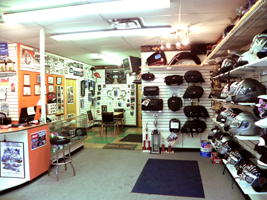Comprehending the Essential Parts of a Motorbike: A Comprehensive Guide for Lovers
For motorcycle fanatics looking to elevate their riding experience and ensure their bikes run smoothly, comprehending the crucial components of a motorcycle is paramount. Each component, from the engine's elaborate operations to the critical duty of the stopping mechanisms, not only influences efficiency yet also security and convenience.
Engine Elements

The camshaft plays an essential duty in controlling the timing of the engine's shutoffs, ensuring the exact opening and closing essential for effective gas and air consumption, in addition to exhaust expulsion. This timing is essential to maintaining ideal engine performance and performance. Additionally, the carburetor or gas shot system, depending on the motorbike version, is accountable for blending air with gas in the correct ratio for burning.
The air conditioning system, either air or liquid-based, works to preserve the engine's temperature level within functional restrictions, preventing overheating and making certain longevity - mx gear nz. Each element, thoroughly made and integrated, adds to the smooth procedure of the engine, defining the motorcycle's power outcome and overall performance
Transmission System
Integral to the motorbike's performance, the transmission system makes sure reliable power transfer from the engine to the wheels. This system consists of a number of essential parts, consisting of the clutch, transmission, and last drive, each playing a vital duty in equating the engine's power right into motion. The clutch, normally run by a hand bar, serves to disengage the engine and engage from the transmission, permitting smooth gear changes and controlled velocity.
The transmission, often described as the transmission correct, has a collection of equipments that motorcyclists can by hand move through to adjust the bike's speed and torque result. These equipments are set up in a series that allows the motorbike to increase smoothly and keep optimal engine performance across various rates. Most motorcycles utilize a sequential transmission, requiring the motorcyclist to move equipments in an established order.
Braking Mechanisms
While understanding the transmission system is vital to using a motorbike's power, just as vital is the capacity to control and quit that power effectively, which is where stopping mechanisms enter play. Brakes are vital for safety and security and efficiency, providing the cyclist with the required control to navigate various surfaces and conditions. Commonly, bikes include two types of braking systems: disc brakes and drum brakes.
Disc brakes are extra common in modern motorbikes due to their premium performance. They contain a brake Get the facts disc, caliper, and pads. When activated, the caliper presses the brake pads against the rotating disc, transforming kinetic energy right into warm, thereby reducing the wheel. This system provides far better warm dissipation, regular performance, and improved stopping power, specifically in wet problems.
Conversely, drum brakes, though less typical, are still located in some motorcycles. They work by pressing brake footwear versus the internal surface area of a drum affixed to the wheel. While normally much less reliable in warmth dissipation and stopping power, drum brakes are less complex and much more cost-efficient.
Understanding these braking systems' nuances enables cyclists to keep their motorcycles effectively and appreciate the engineering that guarantees risk-free and effective stopping.
Suspension and Steering
Suspension and steering systems are essential parts that significantly affect a bike's handling and ride convenience. The suspension system, containing forks at the front and shock absorbers at the back, soaks up roadway abnormalities, boosting security and control. Front forks, generally telescopic or inverted, compress and rebound to alleviate effects, while rear shock absorbers maintain tire call with the road, crucial for grip and safety and security.
Guiding, focused around the handlebars, attaches the motorcyclist to the motorbike's directional control. The steering head bearings guarantee smooth operation, enabling precise ability to move. Proper alignment and upkeep of these bearings are vital for predictable steering reaction and reducing cyclist exhaustion.
The suspension's adjustability is one more vital element; preload, damping, and rebound settings permit modification to fit various riding problems and styles. This flexibility is necessary for optimizing efficiency, whether navigating city streets or taking on tough trails. Advancements like electronic suspension systems supply real-time modifications, enhancing adventure high quality across varied surfaces.

Electrical Equipments
After guaranteeing a controlled and smooth experience via effective suspension and steering systems, attention transforms to the electrical systems, a critical facet of modern bikes. These systems play a crucial role not only in beginning the engine but additionally in powering numerous components that improve the functionality and safety of the motorcycle.
At the heart of a bike's electrical system is the battery, which shops electrical energy required for beginning the engine and powering supporting systems - mx parts nz. The alternator or generator, combined with the rectifier-regulator, guarantees the battery remains charged while the bike functions, transforming mechanical power right into electric energy and preserving voltage degrees
The ignition system, one more important component, is in charge of igniting the air-fuel mix in the engine's cylinders. Modern motorbikes commonly utilize a digital ignition system, offering better effectiveness and dependability contrasted to traditional systems.
Illumination systems, consisting of fronts lights, tail lights, and indications, are likewise important, making certain presence and safety and security for the biker. Additional electronic parts such as sensing units, control units, and shows add to sophisticated attributes like gas shot administration, anti-lock braking systems (ABDOMINAL), and digital control panels, further enhancing the riding experience.
Conclusion
A detailed comprehension of a bike's essential elements, consisting of the engine, transmission system, stopping devices, suspension, find more guiding, and electric systems, is crucial for enthusiasts intending to enhance comfort, safety, and efficiency. Mastery of these aspects permits notified choices concerning upkeep and upgrades, inevitably enhancing the riding experience. By incorporating this knowledge, bikers can guarantee their motorcycles operate at peak performance and dependability, therefore making the most of both satisfaction and long life of their lorries.
For motorbike visit here lovers looking to elevate their riding experience and guarantee their bikes run efficiently, understanding the necessary parts of a motorcycle is critical.Important to the bike's capability, the transmission system ensures efficient power transfer from the engine to the wheels.While comprehending the transmission system is crucial to using a bike's power, similarly crucial is the capacity to regulate and quit that power properly, which is where stopping devices come right into play. Typically, motorcycles include 2 kinds of stopping systems: disc brakes and drum brakes.
A thorough comprehension of a motorcycle's important components, including the engine, transmission system, braking mechanisms, suspension, guiding, and electric systems, is vital for lovers aiming to enhance efficiency, convenience, and safety and security.